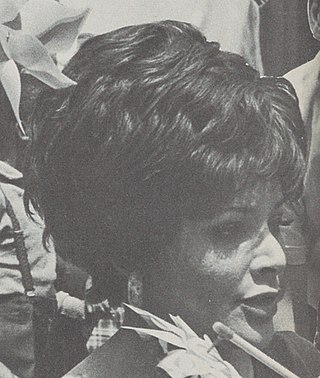Related Research Articles

The DuMont Television Network was one of America's pioneer commercial television networks, rivaling NBC and CBS for the distinction of being first overall in the United States. It was owned by Allen B. DuMont Laboratories, a television equipment and television set manufacturer, and began operation on April 13, 1940.
The year 1952 in television involved some significant events. Below is a list of television-related events during 1952.

Desilu Productions, Inc. was an American television production company founded and co-owned by husband and wife Desi Arnaz and Lucille Ball. The company is best known for shows such as I Love Lucy, The Lucy Show, Mannix, The Untouchables, Mission: Impossible and Star Trek. Until 1962, Desilu was the second-largest independent television production company in the United States, behind MCA's Revue Studios, until MCA bought Universal Pictures and Desilu became and remained the number-one independent production company, until Ball sold it to Gulf and Western Industries in 1968.

Family Matters is an American television sitcom that debuted on ABC on September 22, 1989, and ended on May 9, 1997. However it moved to CBS, where it was shown from September 19, 1997, to July 17, 1998. A spin-off of Perfect Strangers, the series revolves around the Winslow family, an African-American middle class family living in Chicago, Illinois. Midway through the first season, the show introduced the Winslows' nerdy neighbor Steve Urkel, who was originally scripted to appear as a one-time character. However, he quickly became the show's breakout character, joining the main cast.
WBZ-TV is a television station in Boston, Massachusetts, United States, serving as the market's CBS outlet. It is owned and operated by the network's CBS News and Stations division alongside independent WSBK-TV. Both stations share studios on Soldiers Field Road in the Allston–Brighton section of Boston. WBZ-TV's transmitter is located on Cedar Street in Needham, Massachusetts, on a tower site that was formerly owned by CBS and is now owned by American Tower Corporation.
KYW-TV, branded CBS Philadelphia, is a television station in Philadelphia, Pennsylvania, United States, serving as the market's CBS outlet. It is owned and operated by the network's CBS News and Stations division alongside independent station WPSG. The two stations share studios on Hamilton Street north of Center City, Philadelphia; KYW-TV's transmitter is located in the city's Roxborough section.

WCAU is a television station in Philadelphia, Pennsylvania, United States, serving as the market's NBC outlet. It is owned and operated by the network's NBC Owned Television Stations division alongside Mount Laurel, New Jersey–licensed Telemundo outlet WWSI ; it is also sister to regional sports network NBC Sports Philadelphia.

WPVI-TV, branded 6 ABC, is a television station in Philadelphia, Pennsylvania, United States, serving as the market's ABC outlet. Owned and operated by the network's ABC Owned Television Stations division, the station maintains studios on City Avenue in the Wynnefield Heights section of Philadelphia, and a transmitter in the city's Roxborough neighborhood.

WOGL is a commercial radio station licensed to serve Philadelphia, Pennsylvania. The station is owned by Audacy, Inc. and broadcasts a classic hits radio format. The broadcast tower used by the station is located in the Roxborough section of Philadelphia, at. The station's studios and offices are co-located within Audacy's corporate headquarters in Center City, Philadelphia. The station features mostly hits from the 1970s, 1980s and 1990s with some 2000s hits.
WXTU is a commercial radio station in Philadelphia, Pennsylvania. Owned by Beasley Broadcast Group, the station broadcasts a country music format. Its studios and offices are located at 1 Bala Plaza on East City Avenue in Bala Cynwyd, Pennsylvania, while its transmitter is located in the Roxborough section of the city.

WPHT is a commercial radio station licensed to Philadelphia, Pennsylvania. The station broadcasts a talk radio format and is owned by Audacy, Inc. Its studios are in Audacy's corporate headquarters in Center City, Philadelphia, and its transmitter and broadcast tower are in Moorestown, New Jersey.
John Francis Whitaker was an American sportscaster who worked for both CBS and ABC. Whitaker was a decorated army veteran of World War II. He fought in the Normandy Campaign and was wounded by an artillery strike.

Thomas Jefferson Brookshier was an American professional football player, coach, and sportscaster. He was a starting defensive back for the Philadelphia Eagles of the National Football League (NFL) for seven seasons, from 1953 to 1961. He later paired with Pat Summerall on the primary broadcast team for NFL games on CBS during the 1970s.

The Stranger is an American television crime drama broadcast on the DuMont Television Network from June 25, 1954, to February 11, 1955.
The Range Rider is an American Western television series that was first broadcast in syndication from 1951 to 1952. A single lost episode surfaced and was broadcast in 1959. In 1954, the BBC purchased rights to show the program in the UK . It was also shown in Melbourne, Australia, during the 1950s. It was broadcast in Canada and in Rome.

Elliott Lawrence Broza, known professionally as Elliott Lawrence, was an American jazz pianist and bandleader.
Ron Joseph was an American television producer known for his dance shows. On his shows, he was usually referred to as RJ.

Edie Huggins was an American television reporter, journalist and broadcaster. In 1966, Huggins became one of the first African American women to report on television in Philadelphia, remaining a fixture on WCAU-TV for 42 years; the longest consecutive television run of any Philadelphia TV news reporter in history.
The Marshal of Gunsight Pass is an American live broadcast Western television series that began on March 12, 1950, and ended on September 30, 1950, with a one-month hiatus in April and May.
Adventure is a documentary television series that aired on CBS beginning in 1953. The series was produced in collaboration with the American Museum of Natural History and hosted by Charles Collingwood. The program consisted of interviews with scientists and academicians and films of anthropological expeditions.
References
- 1 2 3 Hyatt, Wesley (1997). The Encyclopedia of Daytime Television. Watson-Guptill Publications. p. 6. ISBN 978-0823083152 . Retrieved 22 March 2020.
- ↑ Woolery, George W. (1985). Children's Television: The First Thirty-Five Years, 1946-1981, Part II: Live, Film, and Tape Series. The Scarecrow Press. pp. 10–11. ISBN 0-8108-1651-2.
- 1 2 "Action in the Afternoon". Broadcast Pioneers of Philadelphia. 2005. Archived from the original on 5 July 2008. Retrieved 2008-08-10.
- ↑ Marill, Alvin H. (2011). Television Westerns: Six Decades of Sagebrush Sheriffs, Scalawags, and Sidewinders. Scarecrow Press. ISBN 978-0-8108-8133-4 . Retrieved January 21, 2020.
- 1 2 "The Broadcast Pioneers of Philadelphia". Broadcast Pioneers of Philadelphia. 2008. Retrieved 2008-08-10.
- ↑ Vogel, Mark (2016). Monster Mash: The Creepy, Kooky Monster Craze in America 1957-1972. Raleigh, NC: TwoMorrows Publishing. pp. 17–18. ISBN 978-1-60549-064-9.
- ↑ "The New Shows". Time . 1953-02-23. Archived from the original on December 22, 2008. Retrieved 2008-08-10.